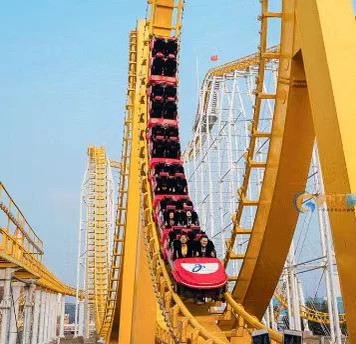- Albanian
- Arabic
- Belarusian
- Bengali
- Czech
- English
- French
- German
- Hebrew
- Hungarian
- Indonesian
- irish
- Italian
- Japanese
- kazakh
- Persian
- Russian
- Thai
- Uzbek
- Vietnamese
Exploring the Thrilling World of Roller Coasters and Their Incredible Designs
The Thrill of Roller Coasters A Journey Through the World of Rides
Roller coasters have long captivated the hearts of thrill-seekers around the globe, drawing millions to amusement parks every year. These mechanical marvels embody a perfect blend of engineering brilliance and adrenaline-pumping excitement. From soaring heights to dizzying speeds, roller coasters offer an unparalleled experience that keeps riders coming back for more. This article delves into the history, types, and cultural significance of roller coasters, exploring why they continue to be a beloved staple of amusement parks.
A Brief History
The concept of roller coasters can be traced back to the 17th century in Russia, where ice slides called “Russian Mountains” gained popularity. These early rides were wooden structures topped with a sloping surface coated in ice, providing a thrilling descent for the brave. As the idea spread throughout Europe, various innovations emerged, leading to the creation of the first true roller coaster in the United States, known as the Switchback Railway. Built in 1884 at Coney Island, New York, this ride featured wooden tracks and offered riders a unique experience that would lay the foundation for future developments in amusement rides.
As technology advanced, so too did the designs of roller coasters. The early 20th century saw the introduction of the loop, allowing riders to experience inverted thrills. The 1970s ushered in a new era of roller coasters featuring complex loops, corkscrews, and multiple inversions. Innovations in materials and engineering allowed for even more daring designs, leading to higher speeds and more intricate courses. The launch of steel roller coasters in the 1970s marked a significant milestone, providing smoother rides and the ability to create more ambitious layouts compared to their wooden predecessors.
Types of Roller Coasters
Roller coasters come in various shapes and sizes, catering to diverse preferences and thrill tolerance levels. Wooden roller coasters are known for their classic charm, characterized by their rickety sounds and nostalgic appeal. These coasters often deliver a unique experience with their heightened vibrations and twisting tracks. On the other hand, steel roller coasters are renowned for their ability to achieve intense speeds and complex inversions.
r rollercoasters

Among the most exhilarating types are inverted roller coasters, where riders are suspended below the track. This design enhances the sensation of weightlessness and offers a completely different perspective of the ride. Dive coasters, which feature a steep drop, provide an adrenaline rush that is hard to replicate, as riders plummet vertically before careening into loops or turns.
For those seeking a different kind of thrill, hybrid coasters combine wooden and steel elements, creating a blend of smoothness and traditional wooden coaster charm. Additionally, family-friendly coasters provide gentler experiences, allowing younger riders or those with less adventurous spirits to enjoy the excitement of roller coasters without overwhelming them.
Cultural Impact and Popularity
Roller coasters have transcended their status as mere amusement park rides to become cultural icons. They symbolize the spirit of adventure and the pursuit of thrills. Television shows and feature films frequently depict roller coasters as settings for unforgettable moments, from humorous mishaps to breathtaking escapades. Parks such as Disneyland and Six Flags have established reputations for their innovative and record-breaking coasters, turning them into pilgrimage sites for coaster enthusiasts.
The rise of social media has further amplified the thrill of roller coasters. Riders eagerly share their experiences, ranging from heart-pounding screams to exhilarating videos capturing hair-raising drops and loops. This sharing culture has inspired a new generation to embark on roller coaster journeys, continually driving interest and participation in the amusement park experience.
Conclusion
In conclusion, roller coasters continue to be a thrilling mainstay in amusement parks around the world. Their evolution from humble beginnings to engineering marvels highlights the human fascination with speed, height, and the unknown. As technology progresses, we can only imagine the future innovations that will shape the roller coasters of tomorrow. Whether one seeks the nostalgia of wooden coasters or the modern thrills of steel beasts, roller coasters promise an unforgettable adventure and an exhilarating escape from the mundane. So, buckle up, scream your heart out, and embrace the ride of a lifetime!
-
Flume Ride-Hebei Zhipao Amusement Equipment Manufacturing Co., Ltd.|Thrilling Water Attraction&Customizable DesignJul.30,2025
-
Flume Ride - Hebei Zhipao Amusement Equipment | Water Coaster, Thrilling DescentJul.30,2025
-
Flume Ride - Hebei Zhipao | Thrilling Water AttractionJul.30,2025
-
Flume Ride: Thrilling Water Attraction by Hebei Zhipao|Log Flume Manufacturers&Flume Ride DesignJul.30,2025
-
Flume Ride-Hebei Zhipao Amusement Equipment Manufacturing Co., Ltd.|Thrilling Water Coaster, Safe DesignJul.30,2025
-
Flume Ride-Hebei Zhipao Amusement Equipment Manufacturing Co., Ltd.|Thrilling Water Attraction, Safe DesignJul.30,2025
